Iron Deficiency Problem in India: A Comprehensive Report
VerifiedAdded on 2022/11/04
|8
|1671
|120
Report
AI Summary
This report provides a detailed analysis of the iron deficiency problem in India, a significant public health concern. It explores the high prevalence of Iron Deficiency Anemia (IDA), particularly among women and children, and its impact on national health. The report examines the geographical, social, political, and economic factors contributing to the problem. It discusses existing intervention programs, including dietary fortification, diversification, and medicinal supplementation with folic acid and iron. The strengths, weaknesses, and challenges of these programs are critically evaluated, including issues such as low political commitment, inadequate coverage, and lack of compliance. The report also suggests ways to address the iron deficiency problem, emphasizing evidence-based approaches, food-based strategies, and the importance of key players like the government and health ministry. The feasibility and practicality of these interventions are discussed, considering factors like literacy levels and access to resources. The report concludes by highlighting the need for a comprehensive and sustainable approach to tackle iron deficiency in India.
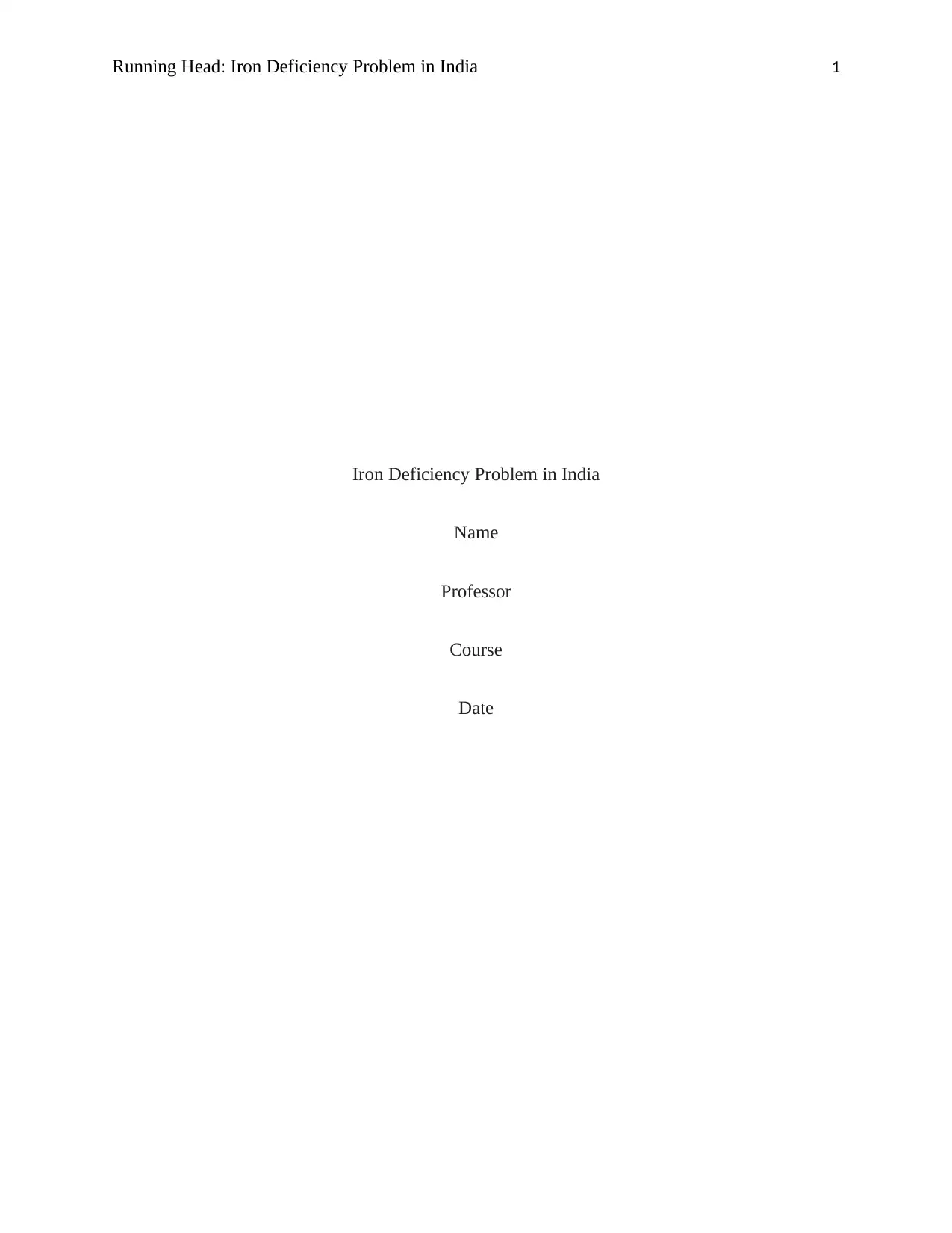
Running Head: Iron Deficiency Problem in India 1
Iron Deficiency Problem in India
Name
Professor
Course
Date
Iron Deficiency Problem in India
Name
Professor
Course
Date
Paraphrase This Document
Need a fresh take? Get an instant paraphrase of this document with our AI Paraphraser
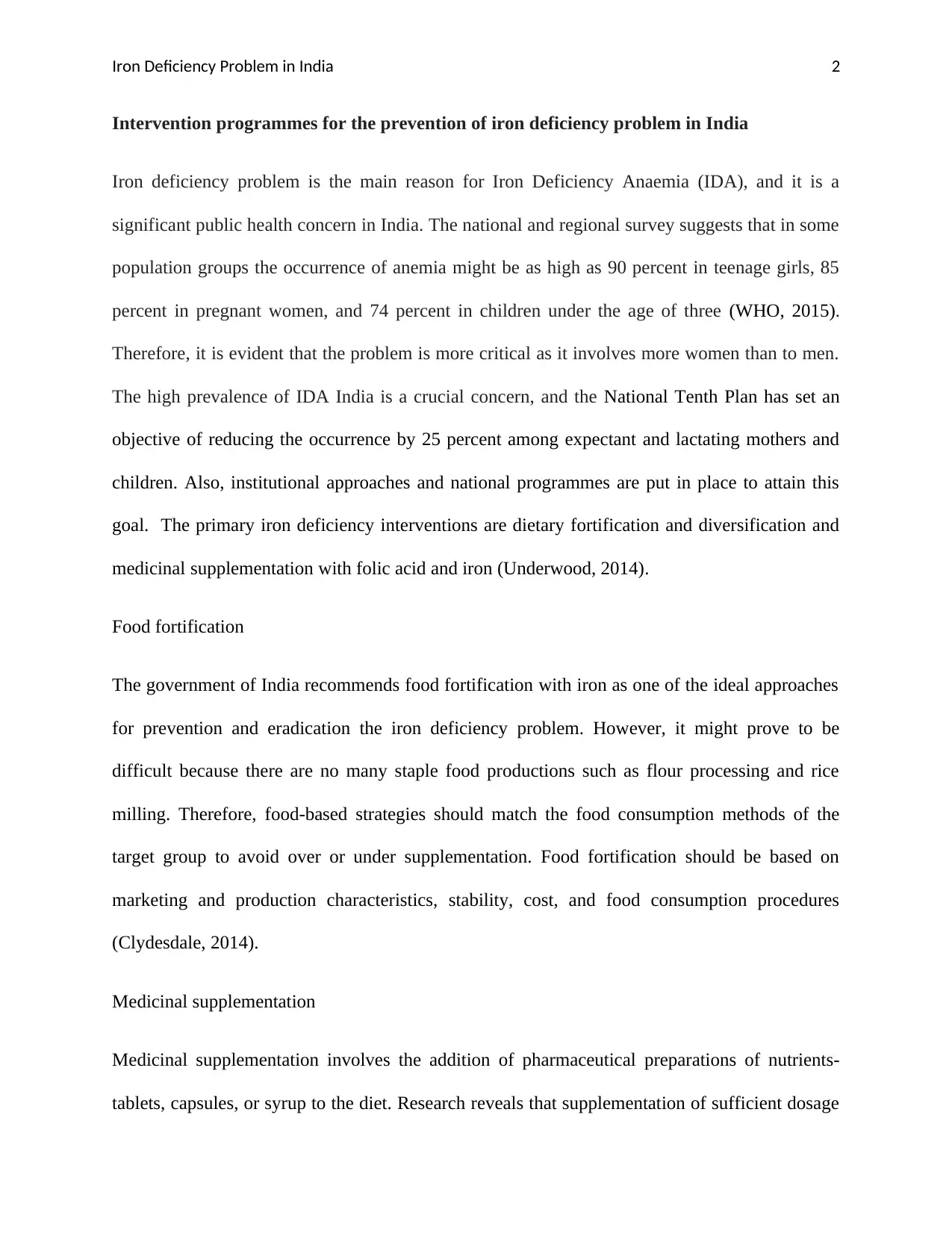
Iron Deficiency Problem in India 2
Intervention programmes for the prevention of iron deficiency problem in India
Iron deficiency problem is the main reason for Iron Deficiency Anaemia (IDA), and it is a
significant public health concern in India. The national and regional survey suggests that in some
population groups the occurrence of anemia might be as high as 90 percent in teenage girls, 85
percent in pregnant women, and 74 percent in children under the age of three (WHO, 2015).
Therefore, it is evident that the problem is more critical as it involves more women than to men.
The high prevalence of IDA India is a crucial concern, and the National Tenth Plan has set an
objective of reducing the occurrence by 25 percent among expectant and lactating mothers and
children. Also, institutional approaches and national programmes are put in place to attain this
goal. The primary iron deficiency interventions are dietary fortification and diversification and
medicinal supplementation with folic acid and iron (Underwood, 2014).
Food fortification
The government of India recommends food fortification with iron as one of the ideal approaches
for prevention and eradication the iron deficiency problem. However, it might prove to be
difficult because there are no many staple food productions such as flour processing and rice
milling. Therefore, food-based strategies should match the food consumption methods of the
target group to avoid over or under supplementation. Food fortification should be based on
marketing and production characteristics, stability, cost, and food consumption procedures
(Clydesdale, 2014).
Medicinal supplementation
Medicinal supplementation involves the addition of pharmaceutical preparations of nutrients-
tablets, capsules, or syrup to the diet. Research reveals that supplementation of sufficient dosage
Intervention programmes for the prevention of iron deficiency problem in India
Iron deficiency problem is the main reason for Iron Deficiency Anaemia (IDA), and it is a
significant public health concern in India. The national and regional survey suggests that in some
population groups the occurrence of anemia might be as high as 90 percent in teenage girls, 85
percent in pregnant women, and 74 percent in children under the age of three (WHO, 2015).
Therefore, it is evident that the problem is more critical as it involves more women than to men.
The high prevalence of IDA India is a crucial concern, and the National Tenth Plan has set an
objective of reducing the occurrence by 25 percent among expectant and lactating mothers and
children. Also, institutional approaches and national programmes are put in place to attain this
goal. The primary iron deficiency interventions are dietary fortification and diversification and
medicinal supplementation with folic acid and iron (Underwood, 2014).
Food fortification
The government of India recommends food fortification with iron as one of the ideal approaches
for prevention and eradication the iron deficiency problem. However, it might prove to be
difficult because there are no many staple food productions such as flour processing and rice
milling. Therefore, food-based strategies should match the food consumption methods of the
target group to avoid over or under supplementation. Food fortification should be based on
marketing and production characteristics, stability, cost, and food consumption procedures
(Clydesdale, 2014).
Medicinal supplementation
Medicinal supplementation involves the addition of pharmaceutical preparations of nutrients-
tablets, capsules, or syrup to the diet. Research reveals that supplementation of sufficient dosage
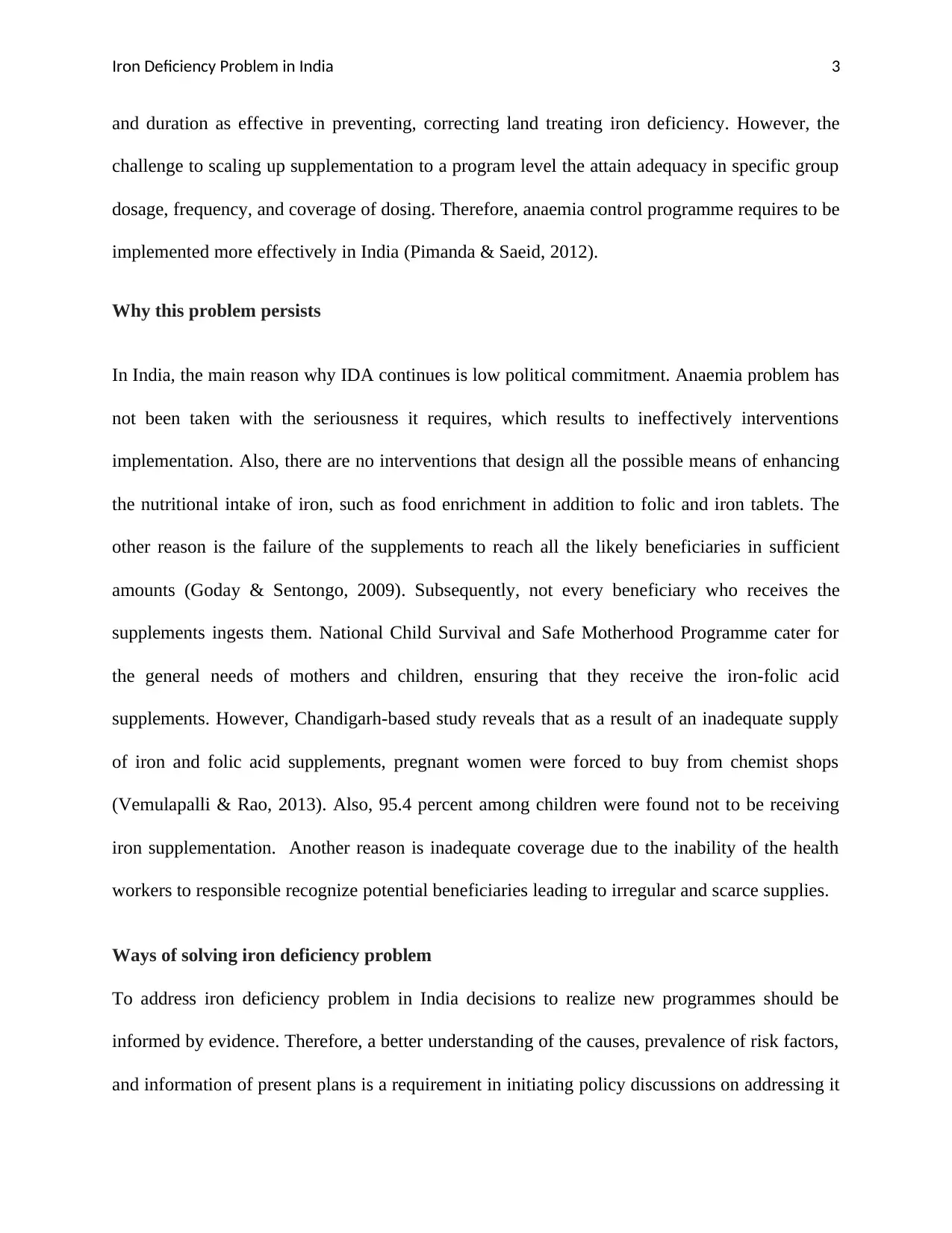
Iron Deficiency Problem in India 3
and duration as effective in preventing, correcting land treating iron deficiency. However, the
challenge to scaling up supplementation to a program level the attain adequacy in specific group
dosage, frequency, and coverage of dosing. Therefore, anaemia control programme requires to be
implemented more effectively in India (Pimanda & Saeid, 2012).
Why this problem persists
In India, the main reason why IDA continues is low political commitment. Anaemia problem has
not been taken with the seriousness it requires, which results to ineffectively interventions
implementation. Also, there are no interventions that design all the possible means of enhancing
the nutritional intake of iron, such as food enrichment in addition to folic and iron tablets. The
other reason is the failure of the supplements to reach all the likely beneficiaries in sufficient
amounts (Goday & Sentongo, 2009). Subsequently, not every beneficiary who receives the
supplements ingests them. National Child Survival and Safe Motherhood Programme cater for
the general needs of mothers and children, ensuring that they receive the iron-folic acid
supplements. However, Chandigarh-based study reveals that as a result of an inadequate supply
of iron and folic acid supplements, pregnant women were forced to buy from chemist shops
(Vemulapalli & Rao, 2013). Also, 95.4 percent among children were found not to be receiving
iron supplementation. Another reason is inadequate coverage due to the inability of the health
workers to responsible recognize potential beneficiaries leading to irregular and scarce supplies.
Ways of solving iron deficiency problem
To address iron deficiency problem in India decisions to realize new programmes should be
informed by evidence. Therefore, a better understanding of the causes, prevalence of risk factors,
and information of present plans is a requirement in initiating policy discussions on addressing it
and duration as effective in preventing, correcting land treating iron deficiency. However, the
challenge to scaling up supplementation to a program level the attain adequacy in specific group
dosage, frequency, and coverage of dosing. Therefore, anaemia control programme requires to be
implemented more effectively in India (Pimanda & Saeid, 2012).
Why this problem persists
In India, the main reason why IDA continues is low political commitment. Anaemia problem has
not been taken with the seriousness it requires, which results to ineffectively interventions
implementation. Also, there are no interventions that design all the possible means of enhancing
the nutritional intake of iron, such as food enrichment in addition to folic and iron tablets. The
other reason is the failure of the supplements to reach all the likely beneficiaries in sufficient
amounts (Goday & Sentongo, 2009). Subsequently, not every beneficiary who receives the
supplements ingests them. National Child Survival and Safe Motherhood Programme cater for
the general needs of mothers and children, ensuring that they receive the iron-folic acid
supplements. However, Chandigarh-based study reveals that as a result of an inadequate supply
of iron and folic acid supplements, pregnant women were forced to buy from chemist shops
(Vemulapalli & Rao, 2013). Also, 95.4 percent among children were found not to be receiving
iron supplementation. Another reason is inadequate coverage due to the inability of the health
workers to responsible recognize potential beneficiaries leading to irregular and scarce supplies.
Ways of solving iron deficiency problem
To address iron deficiency problem in India decisions to realize new programmes should be
informed by evidence. Therefore, a better understanding of the causes, prevalence of risk factors,
and information of present plans is a requirement in initiating policy discussions on addressing it
⊘ This is a preview!⊘
Do you want full access?
Subscribe today to unlock all pages.

Trusted by 1+ million students worldwide
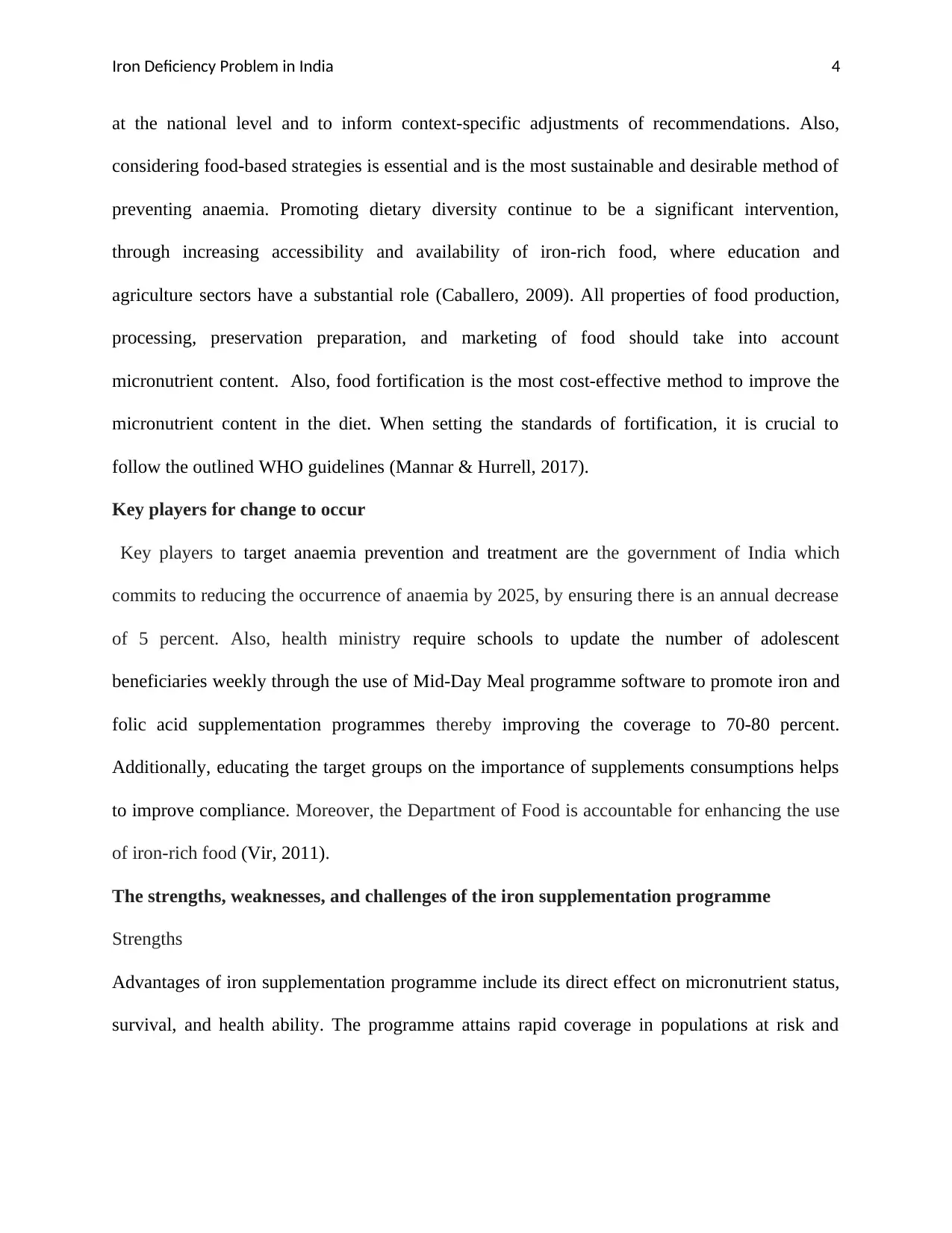
Iron Deficiency Problem in India 4
at the national level and to inform context-specific adjustments of recommendations. Also,
considering food-based strategies is essential and is the most sustainable and desirable method of
preventing anaemia. Promoting dietary diversity continue to be a significant intervention,
through increasing accessibility and availability of iron-rich food, where education and
agriculture sectors have a substantial role (Caballero, 2009). All properties of food production,
processing, preservation preparation, and marketing of food should take into account
micronutrient content. Also, food fortification is the most cost-effective method to improve the
micronutrient content in the diet. When setting the standards of fortification, it is crucial to
follow the outlined WHO guidelines (Mannar & Hurrell, 2017).
Key players for change to occur
Key players to target anaemia prevention and treatment are the government of India which
commits to reducing the occurrence of anaemia by 2025, by ensuring there is an annual decrease
of 5 percent. Also, health ministry require schools to update the number of adolescent
beneficiaries weekly through the use of Mid-Day Meal programme software to promote iron and
folic acid supplementation programmes thereby improving the coverage to 70-80 percent.
Additionally, educating the target groups on the importance of supplements consumptions helps
to improve compliance. Moreover, the Department of Food is accountable for enhancing the use
of iron-rich food (Vir, 2011).
The strengths, weaknesses, and challenges of the iron supplementation programme
Strengths
Advantages of iron supplementation programme include its direct effect on micronutrient status,
survival, and health ability. The programme attains rapid coverage in populations at risk and
at the national level and to inform context-specific adjustments of recommendations. Also,
considering food-based strategies is essential and is the most sustainable and desirable method of
preventing anaemia. Promoting dietary diversity continue to be a significant intervention,
through increasing accessibility and availability of iron-rich food, where education and
agriculture sectors have a substantial role (Caballero, 2009). All properties of food production,
processing, preservation preparation, and marketing of food should take into account
micronutrient content. Also, food fortification is the most cost-effective method to improve the
micronutrient content in the diet. When setting the standards of fortification, it is crucial to
follow the outlined WHO guidelines (Mannar & Hurrell, 2017).
Key players for change to occur
Key players to target anaemia prevention and treatment are the government of India which
commits to reducing the occurrence of anaemia by 2025, by ensuring there is an annual decrease
of 5 percent. Also, health ministry require schools to update the number of adolescent
beneficiaries weekly through the use of Mid-Day Meal programme software to promote iron and
folic acid supplementation programmes thereby improving the coverage to 70-80 percent.
Additionally, educating the target groups on the importance of supplements consumptions helps
to improve compliance. Moreover, the Department of Food is accountable for enhancing the use
of iron-rich food (Vir, 2011).
The strengths, weaknesses, and challenges of the iron supplementation programme
Strengths
Advantages of iron supplementation programme include its direct effect on micronutrient status,
survival, and health ability. The programme attains rapid coverage in populations at risk and
Paraphrase This Document
Need a fresh take? Get an instant paraphrase of this document with our AI Paraphraser
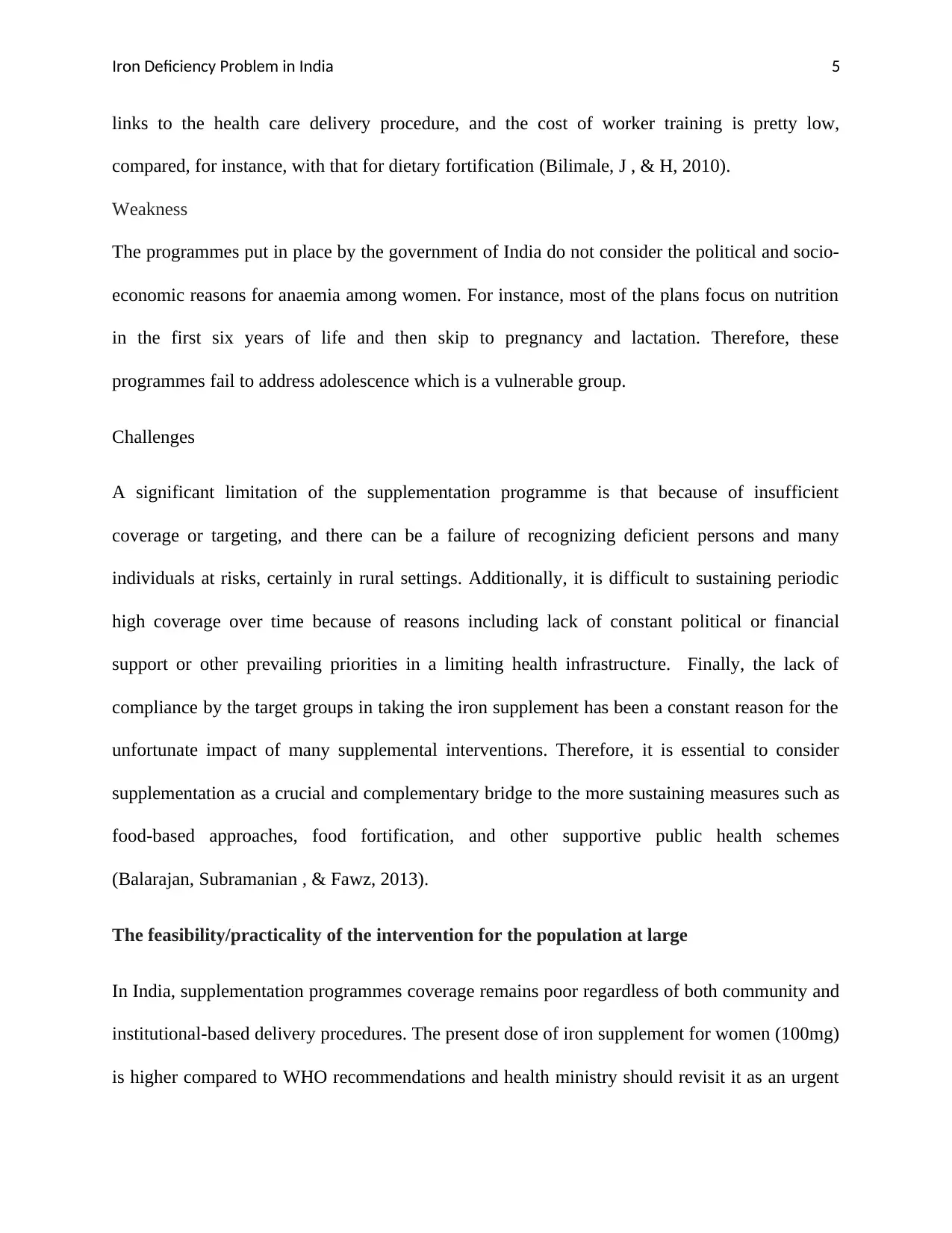
Iron Deficiency Problem in India 5
links to the health care delivery procedure, and the cost of worker training is pretty low,
compared, for instance, with that for dietary fortification (Bilimale, J , & H, 2010).
Weakness
The programmes put in place by the government of India do not consider the political and socio-
economic reasons for anaemia among women. For instance, most of the plans focus on nutrition
in the first six years of life and then skip to pregnancy and lactation. Therefore, these
programmes fail to address adolescence which is a vulnerable group.
Challenges
A significant limitation of the supplementation programme is that because of insufficient
coverage or targeting, and there can be a failure of recognizing deficient persons and many
individuals at risks, certainly in rural settings. Additionally, it is difficult to sustaining periodic
high coverage over time because of reasons including lack of constant political or financial
support or other prevailing priorities in a limiting health infrastructure. Finally, the lack of
compliance by the target groups in taking the iron supplement has been a constant reason for the
unfortunate impact of many supplemental interventions. Therefore, it is essential to consider
supplementation as a crucial and complementary bridge to the more sustaining measures such as
food-based approaches, food fortification, and other supportive public health schemes
(Balarajan, Subramanian , & Fawz, 2013).
The feasibility/practicality of the intervention for the population at large
In India, supplementation programmes coverage remains poor regardless of both community and
institutional-based delivery procedures. The present dose of iron supplement for women (100mg)
is higher compared to WHO recommendations and health ministry should revisit it as an urgent
links to the health care delivery procedure, and the cost of worker training is pretty low,
compared, for instance, with that for dietary fortification (Bilimale, J , & H, 2010).
Weakness
The programmes put in place by the government of India do not consider the political and socio-
economic reasons for anaemia among women. For instance, most of the plans focus on nutrition
in the first six years of life and then skip to pregnancy and lactation. Therefore, these
programmes fail to address adolescence which is a vulnerable group.
Challenges
A significant limitation of the supplementation programme is that because of insufficient
coverage or targeting, and there can be a failure of recognizing deficient persons and many
individuals at risks, certainly in rural settings. Additionally, it is difficult to sustaining periodic
high coverage over time because of reasons including lack of constant political or financial
support or other prevailing priorities in a limiting health infrastructure. Finally, the lack of
compliance by the target groups in taking the iron supplement has been a constant reason for the
unfortunate impact of many supplemental interventions. Therefore, it is essential to consider
supplementation as a crucial and complementary bridge to the more sustaining measures such as
food-based approaches, food fortification, and other supportive public health schemes
(Balarajan, Subramanian , & Fawz, 2013).
The feasibility/practicality of the intervention for the population at large
In India, supplementation programmes coverage remains poor regardless of both community and
institutional-based delivery procedures. The present dose of iron supplement for women (100mg)
is higher compared to WHO recommendations and health ministry should revisit it as an urgent
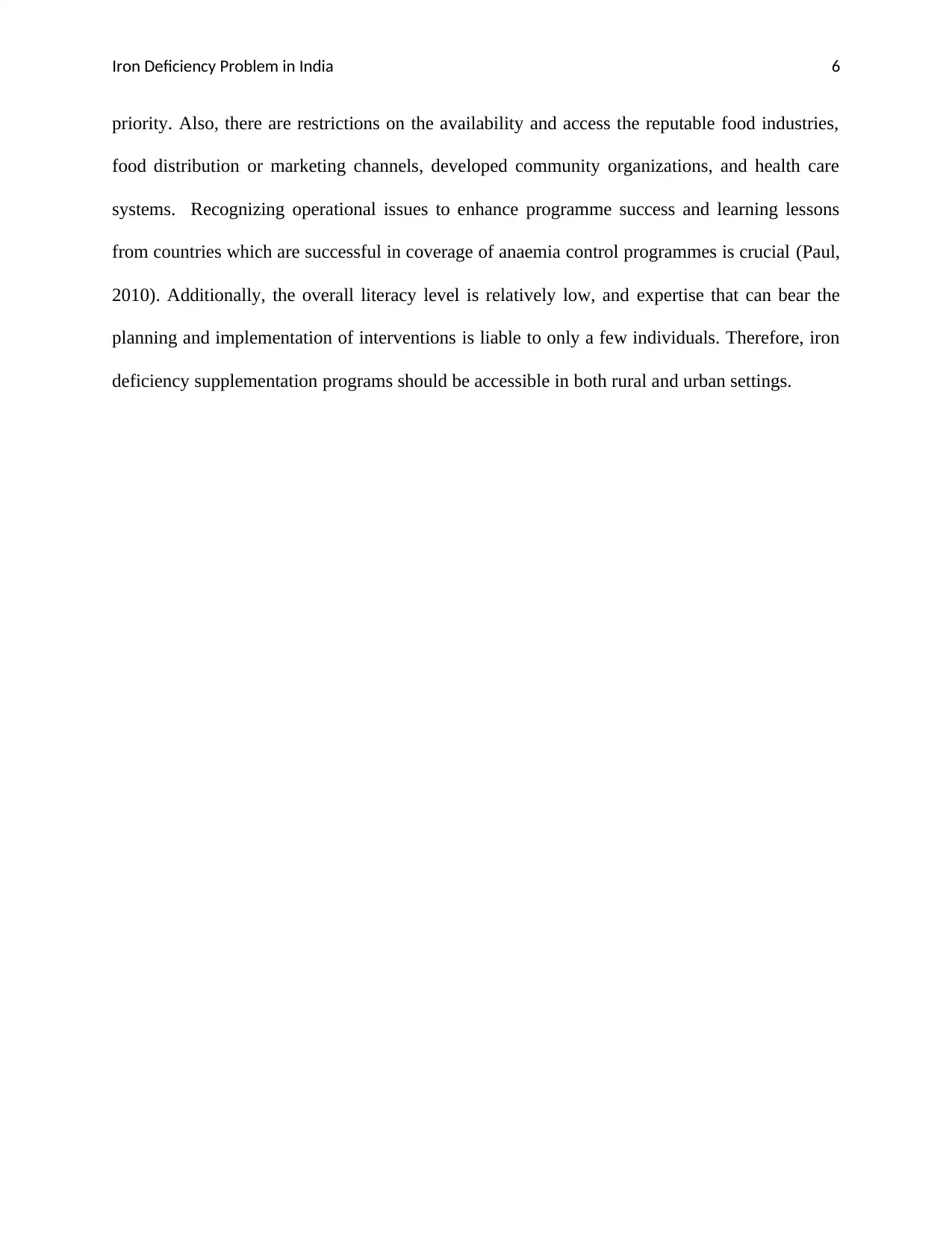
Iron Deficiency Problem in India 6
priority. Also, there are restrictions on the availability and access the reputable food industries,
food distribution or marketing channels, developed community organizations, and health care
systems. Recognizing operational issues to enhance programme success and learning lessons
from countries which are successful in coverage of anaemia control programmes is crucial (Paul,
2010). Additionally, the overall literacy level is relatively low, and expertise that can bear the
planning and implementation of interventions is liable to only a few individuals. Therefore, iron
deficiency supplementation programs should be accessible in both rural and urban settings.
priority. Also, there are restrictions on the availability and access the reputable food industries,
food distribution or marketing channels, developed community organizations, and health care
systems. Recognizing operational issues to enhance programme success and learning lessons
from countries which are successful in coverage of anaemia control programmes is crucial (Paul,
2010). Additionally, the overall literacy level is relatively low, and expertise that can bear the
planning and implementation of interventions is liable to only a few individuals. Therefore, iron
deficiency supplementation programs should be accessible in both rural and urban settings.
⊘ This is a preview!⊘
Do you want full access?
Subscribe today to unlock all pages.

Trusted by 1+ million students worldwide
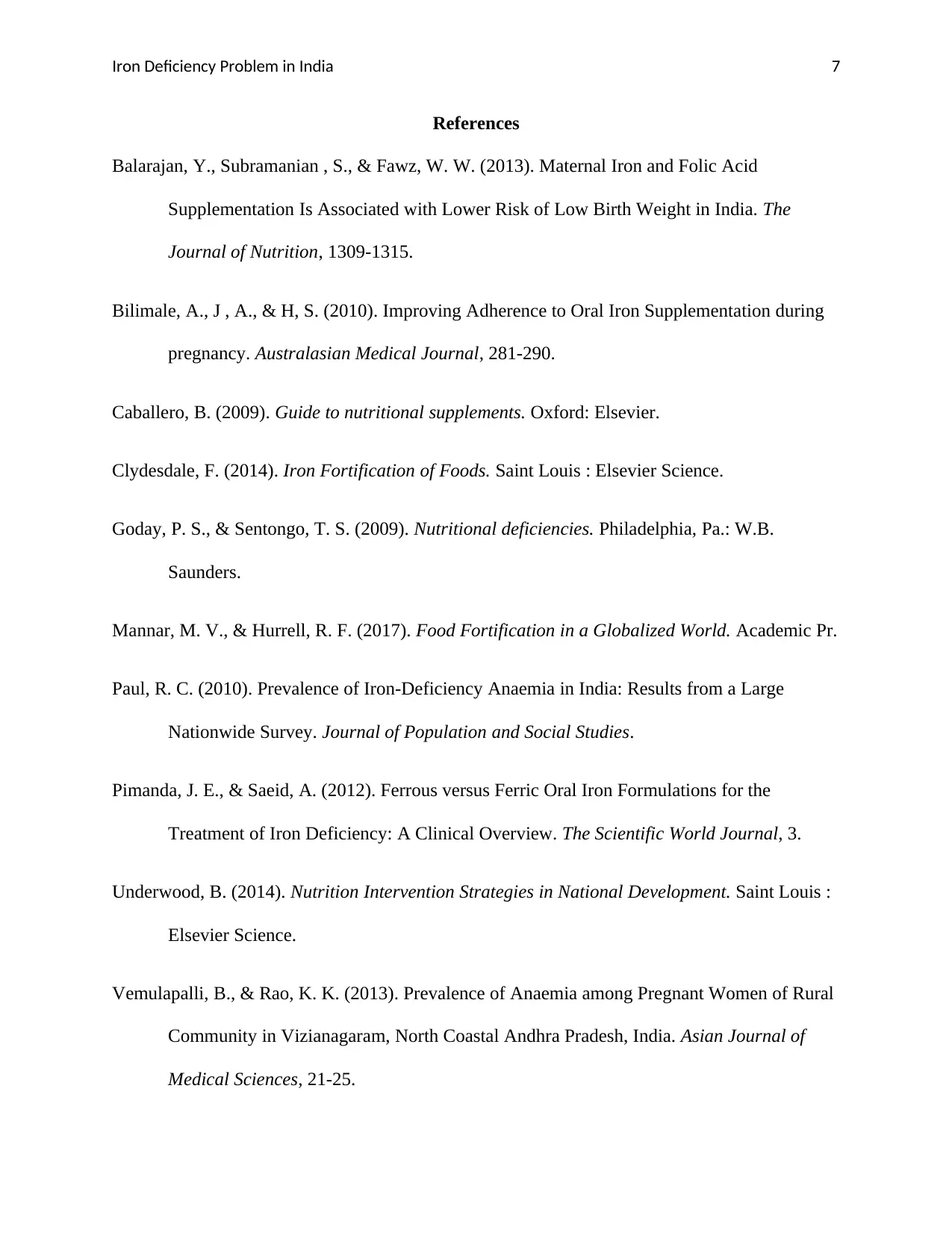
Iron Deficiency Problem in India 7
References
Balarajan, Y., Subramanian , S., & Fawz, W. W. (2013). Maternal Iron and Folic Acid
Supplementation Is Associated with Lower Risk of Low Birth Weight in India. The
Journal of Nutrition, 1309-1315.
Bilimale, A., J , A., & H, S. (2010). Improving Adherence to Oral Iron Supplementation during
pregnancy. Australasian Medical Journal, 281-290.
Caballero, B. (2009). Guide to nutritional supplements. Oxford: Elsevier.
Clydesdale, F. (2014). Iron Fortification of Foods. Saint Louis : Elsevier Science.
Goday, P. S., & Sentongo, T. S. (2009). Nutritional deficiencies. Philadelphia, Pa.: W.B.
Saunders.
Mannar, M. V., & Hurrell, R. F. (2017). Food Fortification in a Globalized World. Academic Pr.
Paul, R. C. (2010). Prevalence of Iron-Deficiency Anaemia in India: Results from a Large
Nationwide Survey. Journal of Population and Social Studies.
Pimanda, J. E., & Saeid, A. (2012). Ferrous versus Ferric Oral Iron Formulations for the
Treatment of Iron Deficiency: A Clinical Overview. The Scientific World Journal, 3.
Underwood, B. (2014). Nutrition Intervention Strategies in National Development. Saint Louis :
Elsevier Science.
Vemulapalli, B., & Rao, K. K. (2013). Prevalence of Anaemia among Pregnant Women of Rural
Community in Vizianagaram, North Coastal Andhra Pradesh, India. Asian Journal of
Medical Sciences, 21-25.
References
Balarajan, Y., Subramanian , S., & Fawz, W. W. (2013). Maternal Iron and Folic Acid
Supplementation Is Associated with Lower Risk of Low Birth Weight in India. The
Journal of Nutrition, 1309-1315.
Bilimale, A., J , A., & H, S. (2010). Improving Adherence to Oral Iron Supplementation during
pregnancy. Australasian Medical Journal, 281-290.
Caballero, B. (2009). Guide to nutritional supplements. Oxford: Elsevier.
Clydesdale, F. (2014). Iron Fortification of Foods. Saint Louis : Elsevier Science.
Goday, P. S., & Sentongo, T. S. (2009). Nutritional deficiencies. Philadelphia, Pa.: W.B.
Saunders.
Mannar, M. V., & Hurrell, R. F. (2017). Food Fortification in a Globalized World. Academic Pr.
Paul, R. C. (2010). Prevalence of Iron-Deficiency Anaemia in India: Results from a Large
Nationwide Survey. Journal of Population and Social Studies.
Pimanda, J. E., & Saeid, A. (2012). Ferrous versus Ferric Oral Iron Formulations for the
Treatment of Iron Deficiency: A Clinical Overview. The Scientific World Journal, 3.
Underwood, B. (2014). Nutrition Intervention Strategies in National Development. Saint Louis :
Elsevier Science.
Vemulapalli, B., & Rao, K. K. (2013). Prevalence of Anaemia among Pregnant Women of Rural
Community in Vizianagaram, North Coastal Andhra Pradesh, India. Asian Journal of
Medical Sciences, 21-25.
Paraphrase This Document
Need a fresh take? Get an instant paraphrase of this document with our AI Paraphraser
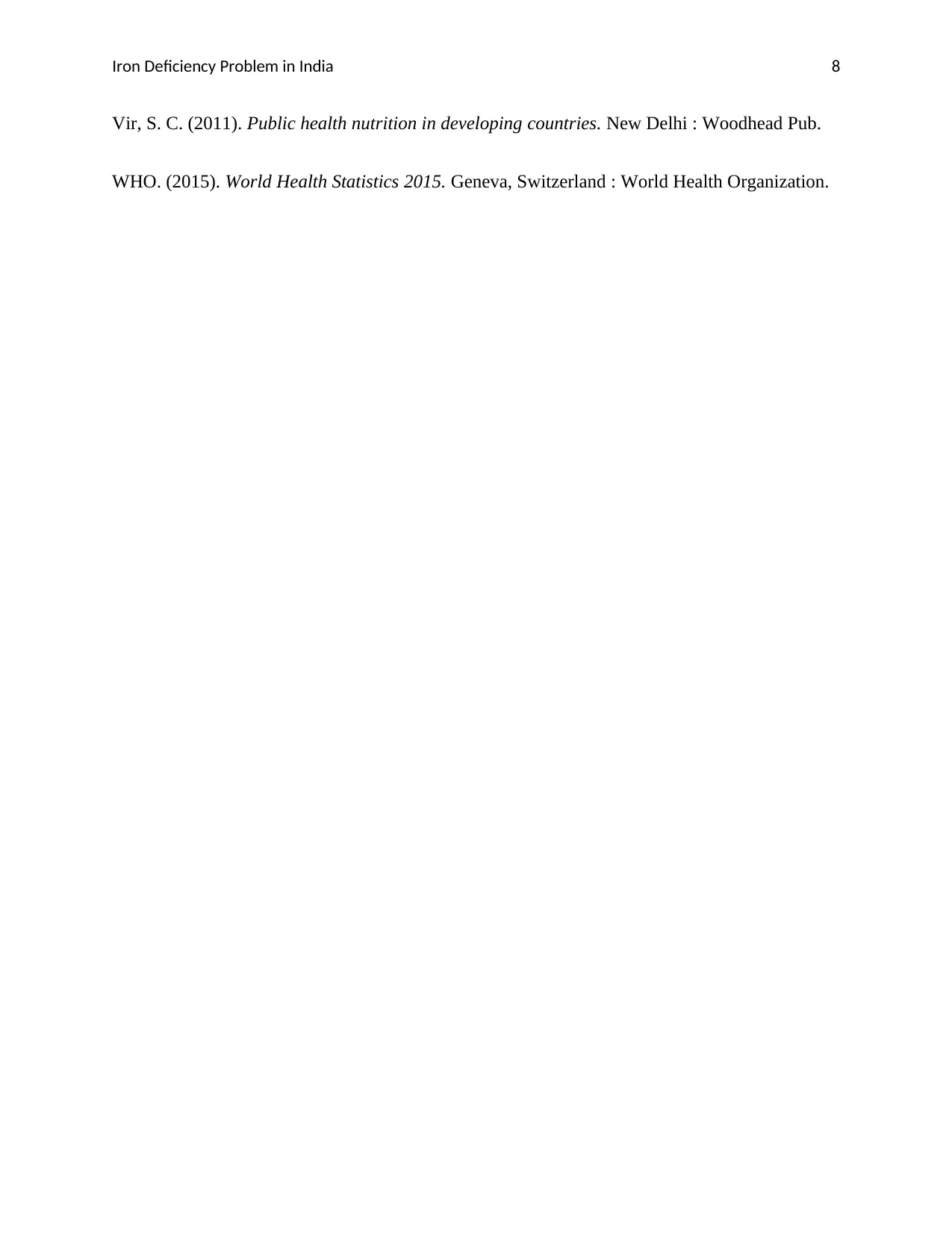
Iron Deficiency Problem in India 8
Vir, S. C. (2011). Public health nutrition in developing countries. New Delhi : Woodhead Pub.
WHO. (2015). World Health Statistics 2015. Geneva, Switzerland : World Health Organization.
Vir, S. C. (2011). Public health nutrition in developing countries. New Delhi : Woodhead Pub.
WHO. (2015). World Health Statistics 2015. Geneva, Switzerland : World Health Organization.
1 out of 8